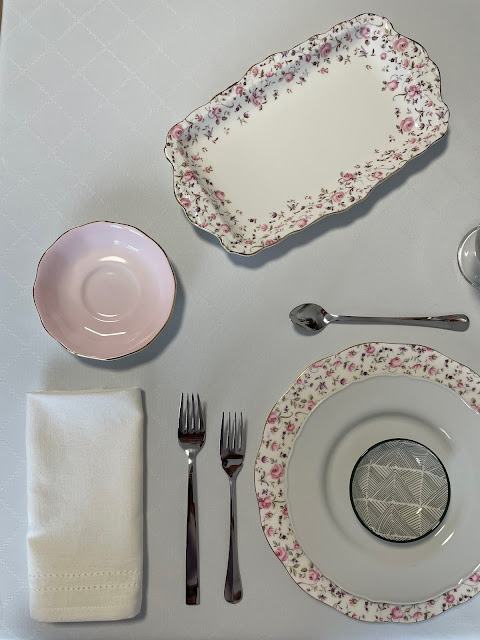Meet Alisa Kazka. Alisa is a Blue Ribbon Award Winner from our Second Annual International Place Setting Competition. Alisa is shown sitting at her Regency Era place setting. 🍽️🍽️🍽️🍽️🍽️🍽️
Alisa Kazka is an etiquette consultant and a table setting specialist from Ukraine. Alisa writes, lectures and provides etiquette training. She told us that she is currently living in Kyiv, because her hometown is not safe. Alisa wrote, “The love for this topic appeared in my childhood and I gradually studied and got acquainted with etiquette and art of table setting. I really love the beauty and cosiness in the house, so I apply the knowledge that I share with my students to my home. I love beautiful porcelain and use it every day in serving.”
Congratulations, Alisa!
 |
| Alisa’s choice of table elements was surprising, until we learned of her circumstances. Alisa was living away from her home and her country, due to the war in Ukraine. She could only use what was on-hand where she was temporarily living. |
What an inviting menu for an Italian with a love for Italian foods! This is a table I’d love to sit at for dinner. We would have loved to have seen a menu more in line with foods that one generally thinks of during the Regency Era, but I’m certain that a soup, vegetables with pasta, fish with white wine, and ices, etc… were likely served on fine tables of the era.
1. How did you choose the menu and various elements you used in your setting and why? Please explain each of the utensils in your setting… For which of the foods on your menu (or course) was each different item intended?
1) My table setting consists primarily of knowledge and love for porcelain, history, etiquette, and beauty. The menu is made up of favorite dishes of the Italian kitchen, which I am a fan of.
You may notice that cutlery is not from the same collection and modern production. Unfortunately, due to the war in Ukraine, I am far from home, my favorite dishes and serving items were left at home, so I didn’t have to choose dishes and cutlery. But, it was very important for me to take part in this competition, to represent my country and myself as a professional, so I took what was in my temporary home and fit the beautiful Regency Era theme.
I wanted to create an airy, romantic table setting that would capture the spirit of the era - Royal Albert porcelain did a great job of emphasizing this, and antique-style glasses from a nearby store helped to set the necessary accent.
2. Why did you choose this particular period in time to set your table?
2) Regency Era is my favorite, it's an inspiring time with a unique style and exquisite porcelain, the spirit of that era, dresses and balls, good manners, and incredibly beautiful table setting. When I saw the proposed list, I didn’t doubt for a second what to choose! I really wanted to show this in my table setting.
3. How, if at all, did Covid-related social restrictions affect your choice of setting? Were you ready to celebrate? Feeling in the mood to do something different? Etc…
3) Covid did not affect the choice of conditions. And if my family were nearby, I would gladly celebrate with them. But, due to the events in Ukraine, I was forced to leave the house, so I will celebrate with my relatives via video call.
4. Have you always enjoyed a properly set table? Or, if not, was the table setting something you learned to enjoy through your social life and/or business later on in life?
4) I have loved tableware since childhood. It has always been important for me that the table should be beautiful: a white tablecloth, porcelain, and beautiful tea pairs for breakfast.
I often helped my grandmother to decorate the table, and arrange cutlery. Like many years ago, I still love the perfect table, beautifully served food, English porcelain, and French faience, always flowers and appropriate decor. In such an atmosphere, communication with family becomes special.
5. Did you do any research on table setting etiquette before setting your elements at the table?
5) Yes, sure! I professionally study the subject of etiquette and table setting. Before participating in the International Place Setting Competition, I also re-read Maura Graber's articles about the Regency Era and was inspired by films about this era.
6. Do you plan on entering again next year?
6) Yes, with great pleasure! I was very happy to take part in the International Place Setting Competition, it gave me inspiration and the push to move on! I want to thank Elizabeth Soos and Maura J. Graber for the opportunity to participate and show my knowledge, experience, and love for table setting, to be inspired and filled with strength to go forward!
Elizabeth Soos and I would both like to congratulate Alisa on her award winning setting. We are honored that she entered our contest and love meeting others who are so willing to share their talents, enthusiasm for etiquette, and their wealth of knowledge. Congratulations!
🍽️Etiquette Enthusiast, Maura J. Graber, is the Site Editor for the Etiquipedia© Etiquette Encyclopedia
























